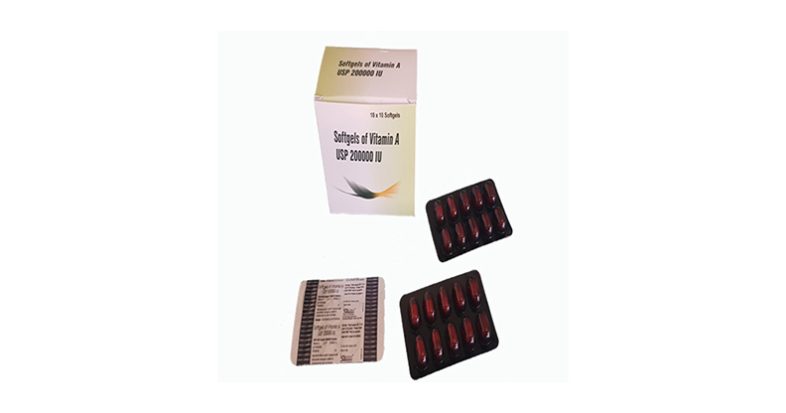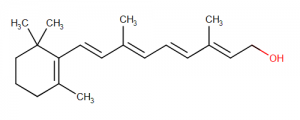VITAMIN A

VITAMIN A USP 2,00,000 I.U. CAPSULE
DESCRIPTION
Retinol and derivatives of retinol that play an essential role in metabolic functioning of the retina, the growth of and differentiation of epithelial tissue, the growth of bone, reproduction, and the immune response. Dietary vitamin A is derived from a variety of carotenoids found in plants. It is enriched in the liver, egg yolks, and the fat component of dairy products.
Retinol and derivatives of retinol that play an essential role in metabolic functioning of the retina, the growth of and differentiation of epithelial tissue, the growth of bone, reproduction, and the immune response. Dietary vitamin A is derived from a variety of carotenoids found in plants. It is enriched in the liver, egg yolks, and the fat component of dairy products.

COMPOSITION
- Each soft gelatin capsules contains:
- Vitamin A USP 2,00,000 I.U.
- (As palmitate)
- Excipients Q.S.
- Approved colours used in capsule shell.
PHARMACOLOGY MECHANISM OF ACTION
Vitamin A (all-trans retinol) is converted in the retina to the 11-cis-isomer of retinaldehyde or 11-cis-retinal. 11-cis-retinal functions in the retina in the transduction of light into the neural signals necessary for vision. 11-cis-retinal, while attached to opsin in rhodopsin is isomerized to all-trans-retinal by light. This is the event that triggers the nerve impulse to the brain which allows for the perception of light. All-trans-retinal is then released from opsin and reduced to all-trans-retinol. All-trans-retinol is isomerized to 11-cis-retinol in the dark, and then oxidized to 11-cis-retinal. 11-cis-retinal recombines with opsin to re-form rhodopsin. Night blindness or defective vision at low illumination results from a failure to re-synthesize 11-cis retinal rapidly.
Epithelial differentiation: The role of Vitamin A in epithelial differentiation, as well as in other physiological processes, involves the binding of Vitamin A to two families of nuclear retinoid receptors (retinoic acid receptors, RARs; and retinoid-X receptors, RXRs). These receptors function as ligand-activated transcription factors that modulate gene transcription. When there is not enough Vitamin A to bind these receptors, natural cell differentiation and growth are interrupted.
Epithelial differentiation: The role of Vitamin A in epithelial differentiation, as well as in other physiological processes, involves the binding of Vitamin A to two families of nuclear retinoid receptors (retinoic acid receptors, RARs; and retinoid-X receptors, RXRs). These receptors function as ligand-activated transcription factors that modulate gene transcription. When there is not enough Vitamin A to bind these receptors, natural cell differentiation and growth are interrupted.
PHARMACOKINETICS
ABSORPTION
- Vitamin D analogues are well tolerated in normal daily doses. Chronic excessive dosing can lead to toxicity.
METABOLISM
Hepatic. Retinol is conjugated with glucuronic acid; the B-glucuronide undergoes enterohepatic circulation and oxidation to retinol and retinoic acid. Retinoic acid undergoes decarboxylation and conjugation with glucuronic acid.
PROTEIN BINDING
5% of circulating vitamin A is bound to lipoproteins in blood in normal condition, but may be up to 65% when hepatic stores are saturated because of excessive intake. When released from liver, vitamin A is bound to retinol-binding protein (RBP). Most vitamin A circulates in the form of retinol bound to RBP.
INDICATIONS
EFFECTIVE FOR
- Vitamin A deficiency : Taking vitamin A by mouth is effective for preventing and treating symptoms of vitamin A deficiency. Vitamin A deficiency can occur in people with protein deficiency, diabetes, over-active thyroid, fever, liver disease, cystic fibrosis, or an inherited disorder called abetalipoproteinemia.
POSSIBLY EFFECTIVE FOR
- Breast cancer : Premenopausal women with a family history of breast cancer who consume high levels of vitamin A in their diet seem to have lower risk of breast cancer. It is not known if taking vitamin A supplements has the same benefit.
- Cataracts : People who consume high amounts of vitamin A in their diet seem to have a lower risk of developing cataracts.
- Measles : Taking vitamin A by mouth seems to reduce the risk of measles complications or death in children with measles and vitamin A deficiency.
- Precancerous lesions in the mouth (oral leukoplakia) : Research shows that taking vitamin A can help treat precancerous lesions in the mouth.
- Diarrhea after giving birth : Taking vitamin A, during, and after pregancy reduces diarrhea after giving birth in malnourished women.
- Pregnancy-related death : Taking vitamin A before and during pregnancy seems to reduce the risk of death by 40% in malnourished women.
- Pregnancy-Related Nightblindness : Taking vitamin A during pregnancy seems to reduce nightblindness by 37% in malnourished women. Vitamin A might work better for this condition when taken with zinc.
- Eye disease affecting the retina (retinitis pigmentosa) : Taking vitamin A can slow the progression of an eye disease that causes damage to the retina.
CONTRAINDICATIONS
- Avoid use if hypersensitivity, intravenous use, hypervitaminosis A, malabsorption syndrome (oral therapy) and pregnancy.
DOSAGEDOSAGE AND ADMINISTRATION
- Recommended daily intakes:
- Men – 900 mcg/day (3,000 IU)
- Women – 700 mcg/day (2,333IU)
ADULTS BY MOUTH
General : Recommended Dietary Allowance (RDA) levels for adults have been established: men 14 years and older, 900 mcg/day (3000 IU); women 14 years and older, 700 mcg/day (2300 IU); pregnancy 14 to 18 years, 750 mcg/day (2500 IU); 19 years and older, 770 mcg/day (2600 IU); lactation 14 to 18 years, 1200 mcg/day (4000 IU); 19 years and older, 1300 mcg/day (4300 IU). Tolerable Upper Intake Levels (UL) for vitamin A have also been established. The UL is the highest level of intake that is likely to pose no risk of harmful effects. The ULs for vitamin A are for preformed vitamin A (retinol) and do not include provitamin A carotenoids: adolescents 14 to 18 years (including pregnancy and lactation), 2800 mcg/day (9000 IU); adults age 19 and older (including pregnancy and lactation), 3000 mcg/day (10,000 IU).
CHILDREN BY MOUTH
General : Adequate Intake (AI) levels of vitamin A for infants have been established: birth to 6 months, 400 mcg/day (1300 IU); 7 to 12 months, 500 mcg/day (1700 IU).
ORAL ADMINISTRATION
- Administer vitamin A orally with or after meals.
WARNING &PRECAUTIONS
Warnings
Avoid use if hypersensitivity, intravenous use, hypervitaminosis A, malabsorption syndrome (oral therapy), and pregnancy (recommended daily average).
This medication contains vitamin A. Do not take Retinol, Aquasol A, Retinyl Acetate, or Retinyl Palmitate if you are allergic to vitamin A or any ingredients contained in this drug.
Keep out of reach of children. In case of overdose, get medical help or contact a Poison Control Center immediately.
- Use caution if dose exceeds 25,000 units per day, monitor closely
- Evaluate additional vitamin deficiencies if diagnosis of vitamin deficiency occurs (single vitamin A deficiency rare)
- Monitor prolonged administration over 25,000 units per day, take into account vitamin intake from other dietary and supplement sources
- Efficacy of large systemic doses of 100,000 to 300,000 units per day of vitamin A for the treatment of acne is not established
PREGNANCY& LACTATION
- Oral vitamin A use during pregnancy is generally acceptable. Controlled studies in pregnant women show no evidence of fetal risk
- Use vitamin A (doses exceeding recommended daily average) during pregnancy with caution if benefits outweigh risks. Animal studies show risk and human studies are not available, or neither animal nor human studies were done
- If the vitamin A dose is greater than 6,000 units per day, administered parentally, do not use vitamin A during pregnancy. The risk involved outweighs potential benefits. Safer alternatives exist
- Breastfeeding: vitamin A is distributed into breastmilk, safe at recommended daily average levels
DRUG INTERACTION
- Calcium Carbonate Risedronate : (Minor) Doses in excess of 1,500 to 2,000 mcg per day of Vitamin A may lead to bone loss and will counteract the effects of risedronate therapy.
- Calcium : (Minor) Doses in excess of 1,500 to 2,000 mcg per day of Vitamin A may lead to bone loss and will counteract the effects of supplementation with calcium salts.
- Castor Oil : (Moderate) Absorption of fat-soluble vitamins may be decreased with coadministration of castor oil.
- Cholestyramine : (Moderate) Cholestyramine can decrease the intestinal absorption of fat and fat-soluble vitamins. If used concurrently, administration of the two agents should be staggered for the longest time interval possible.
- Cod Liver Oil : (Severe) Patients should avoid or limit supplementation with vitamin A during treatment with retinoids to avoid potential additive toxic effects.
- Colesevelam : (Moderate) It is not known if colesevelam can reduce the absorption of oral vitamin supplements including fat soluble vitamins A, D, E, and K. To minimize potential interactions, administer vitamins at least 4 hours before colesevelam.
- Colestipol : (Moderate) Separate administration of fat-soluble vitamins by 1 hour before or 4 hours after a colestipol dose to limit effects on oral absorption. Because it sequesters bile acids, colestipol may interfere with normal fat absorption and thus may reduce absorption of fat-soluble vitamins.
- Methoxsalen : (Moderate) Use methoxsalen and retinoids together with caution; the risk of severe burns/phototoxicity may be additive. If concurrent use is necessary, closely monitor patients for signs or symptoms of skin toxicity.
SIDE EFFECT
- Common Side Effects of Vitamin A
- Side effects from taking moderate doses of vitamin A do not occur often.
- Serious Side Effects of Vitamin A
THESE ARE ESPECIALLY LIKELY TO OCCUR UNDER HIGH DOSES OF VITAMIN-A
- Liver damage
- Severe nausea and vomiting
- Sleepiness
- Confusion, quick-temperedness, and altered mental state
- Headache
- Dizziness
- Increased pressure in the space between the skull and brain
- Visual changes
- Enlarged forehead in babies
STORAGE : Store at room temperature.
PRESENTATION : Blister Pack of 10×10 (100 capsules) in a Box

